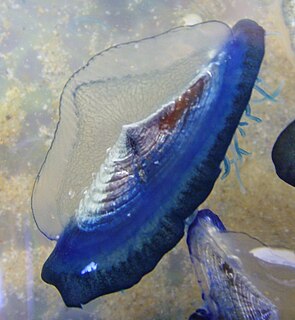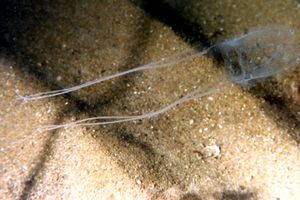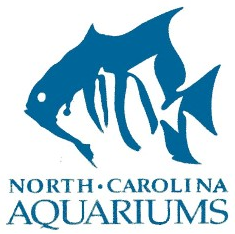
Cnidaria is a phylum under kingdom Animalia containing over 11,000 species of aquatic animals found both in freshwater and marine environments, predominantly the latter.

Jellyfish and sea jellies are the informal common names given to the medusa-phase of certain gelatinous members of the subphylum Medusozoa, a major part of the phylum Cnidaria. Jellyfish are mainly free-swimming marine animals with umbrella-shaped bells and trailing tentacles, although a few are anchored to the seabed by stalks rather than being mobile. The bell can pulsate to provide propulsion for highly efficient locomotion. The tentacles are armed with stinging cells and may be used to capture prey and defend against predators. Jellyfish have a complex life cycle; the medusa is normally the sexual phase, which produces planula larva that disperse widely and enter a sedentary polyp phase before reaching sexual maturity.

Zooplankton are heterotrophic plankton. Plankton are organisms drifting in oceans, seas, and bodies of fresh water. The word zooplankton is derived from the Greek zoon (ζῴον), meaning "animal", and planktos (πλαγκτός), meaning "wanderer" or "drifter". Individual zooplankton are usually microscopic, but some are larger and visible to the naked eye.

The Portuguese man o' war, also known as the man-of-war, bluebottle, or floating terror is a marine hydrozoan found in the Atlantic Ocean and Indian Oceans. It is considered to be the same species as the Pacific man o' war, which is found mainly in the Pacific Ocean.

Box jellyfish are cnidarian invertebrates distinguished by their cube-shaped medusae. Some species of box jellyfish produce potent venom: Chironex fleckeri, Carukia barnesi and Malo kingi. Stings from these and a few other species in the class are extremely painful and can be fatal to humans.

Aurelia aurita is a widely studied species of the genus Aurelia. All species in the genus are closely related, and it is difficult to identify Aurelia medusae without genetic sampling; most of what follows applies equally to all species of the genus. The most common method used to identify the species consists of selecting a jellyfish from a harbour using a device, usually a drinking glass and then photographing the subject. This means that they can be released in to the harbour shortly afterwards and return to their natural habitat.
The pelagic zone consists of the water column of the open ocean, and can be further divided into regions by depth, as illustrated on the right. The word "pelagic" is derived from Ancient Greek πέλαγος (pélagos) 'open sea'. The pelagic zone can be thought of in terms of an imaginary cylinder or water column that goes from the surface of the sea almost to the bottom. Conditions in the water column change with distance from the surface (depth): the pressure increases; the temperature and amount of light decreases; the salinity and amount of dissolved oxygen, as well as micronutrients such as iron, magnesium and calcium, all change.

The lion's mane jellyfish, also known as the giant jellyfish, arctic red jellyfish, or the hair jelly, is one of the largest known species of jellyfish. Its range is confined to cold, boreal waters of the Arctic, northern Atlantic, and northern Pacific Oceans. It is common in the English Channel, Irish Sea, North Sea, and in western Scandinavian waters south to Kattegat and Øresund. It may also drift into the southwestern part of the Baltic Sea. Similar jellyfish – which may be the same species – are known to inhabit seas near Australia and New Zealand. The largest recorded specimen was measured by Alexander Agassiz off the coast of Massachusetts in 1865 and had a bell with a diameter of 210 centimetres and tentacles around 36.6 m (120 ft) long. Lion's mane jellyfish have been observed below 42°N latitude for some time in the larger bays of the east coast of the United States.

Velella is a monospecific genus of hydrozoa in the Porpitidae family. Its only known species is Velella velella, a cosmopolitan free-floating hydrozoan that lives on the surface of the open ocean. It is commonly known by the names sea raft, by-the-wind sailor, purple sail, little sail, or simply Velella.

Carybdea is a genus of venomous box jellyfish within the family Carybdeidae that currently consists of a total of 8 species. This genus of jellyfish are often found in warm waters around the world in waters such as the Mediterranean Sea, the Pacific Ocean, and off the coast of Africa. Their sting can cause a range of effects depending on the species. These invertebrates will go through both sexual and asexual reproduction as they transform from a polyp to medusa. Carybdea have a box-shaped bell with four tentacles and eye-like sensory structures. There are distinct physical markings that differentiate many species within the genus. While Carybdea use their venom to act as predators, they are also preyed on by turtles and various fish. They feed on plankton, invertebrates, fish, and some crustaceans.

Nomeus gronovii, the man-of-war fish, or bluebottle fish, is a species of fish in the family Nomeidae, the driftfish. It is native to the Atlantic, Pacific and Indian Oceans, where adults are generally found at depths from 200 to 1,000 m. It is notable for its ability to live within the deadly tentacles of a siphonophore, the Portuguese man o' war, upon whose tentacles and gonads it feeds. The fish is striped with blackish-blue blemishes covering its body, and the caudal fin is extremely forked. It can reach a length of 39 cm (15 in). It is of minor importance to commercial fisheries. This species is the only known member of its genus.

Cubiceps caeruleus, the blue fathead or cubehead, is a species of driftfish native to the Pacific and Atlantic oceans. It is a pelagic fish that can be found at depths of from 20 to 250 metres. It mostly feeds on salps. This species can reach a length of 25.6 centimetres (10.1 in) TL.

The fathead minnow is a species of temperate freshwater fish belonging to the genus Pimephales of the cyprinid family. The natural geographic range extends throughout much of North America, from central Canada south along the Rockies to Texas, and east to Virginia and the Northeastern United States. This minnow has also been introduced to many other areas via bait bucket releases. Its golden, or xanthic, strain, known as the rosy-red minnow, is a very common feeder fish sold in the United States and Canada. This fish is best known for producing Schreckstoff.
Cubiceps is a genus of driftfishes found circumglobally.

Chrysaora hysoscella, the compass jellyfish, is a common species of jellyfish that inhabits coastal waters in temperate regions of the northeastern Atlantic Ocean, including the North Sea and Mediterranean Sea. In the past it was also recorded in the southeastern Atlantic, including South Africa, but this was caused by confusion with close relatives; C. africana, C. fulgida and an undescribed species tentatively referred to as "C. agulhensis".

A bottom feeder is an aquatic animal that feeds on or near the bottom of a body of water. Biologists often use the terms benthos—particularly for invertebrates such as shellfish, crabs, crayfish, sea anemones, starfish, snails, bristleworms and sea cucumbers—and benthivore or benthivorous, for fish and invertebrates that feed on material from the bottom. However the term benthos includes all aquatic life that lives on or near the bottom, which means it also includes non-animals, such as plants and algae. Biologists also use specific terms that refer to bottom feeding fish, such as demersal fish, groundfish, benthic fish and benthopelagic fish. Examples of bottom feeding fish species groups are flatfish, eels, cod, haddock, bass, grouper, carp, bream (snapper) and some species of catfish and shark.

The magnificent frigatebird or man o' war is a seabird of the frigatebird family Fregatidae. With a length of 89–114 centimetres (35–45 in) and wingspan of 2.17–2.44 m (7.1–8.0 ft) it is the largest species of frigatebird. It occurs over tropical and subtropical waters off America, between northern Mexico and Perú on the Pacific coast and between Florida and southern Brazil along the Atlantic coast. There are also populations on the Galápagos Islands in the Pacific and the Cape Verde islands in the Atlantic.

North Carolina Aquariums is a system of three public aquariums located in Kure Beach, Roanoke Island and Pine Knoll Shores. All are operated by the Aquariums Division of the North Carolina Department of Natural and Cultural Resources since 1976 and are accredited by the Association of Zoos and Aquariums. All three aquariums feature dive shows, live animal encounters, and feeding programs.

Stephanolepis cirrhifer, commonly known as the thread-sail filefish, is a species of marine fish in the family Monacanthidae. It is found in the western Pacific, in an area that ranges from northern Japan to the East China Sea, to Korea. Other common names for the fish include "Kawahagi" "カワハギ" "皮剥" (Japanese) and “쥐치” "Jwi-chi" (Korean). The fish grows to a maximum length of about 12 inches, and consumes both plant material and small marine organisms like skeleton shrimp. S. cirrhifer is host of the parasite Peniculus minuticaudae. Some minor genetic differentiation between S. cirrhifer born in the wild and those bred in a hatchery for consumer use has been shown. The fish is edible and sold commercially for culinary purposes in many Asian countries.

Trachurus lathami is a species of fish in the family Carangidae and the genus Trachurus, the jack mackerels. Common names include rough scad and horse mackerel in English, as well as chinchard frappeur (French), chicharro garretón (Spanish), jurel, and carapau, garaçuma, surel, and xixarro. It is native to parts of the western Atlantic Ocean, including seas off the eastern coasts of North and South America and the Gulf of Mexico.





















